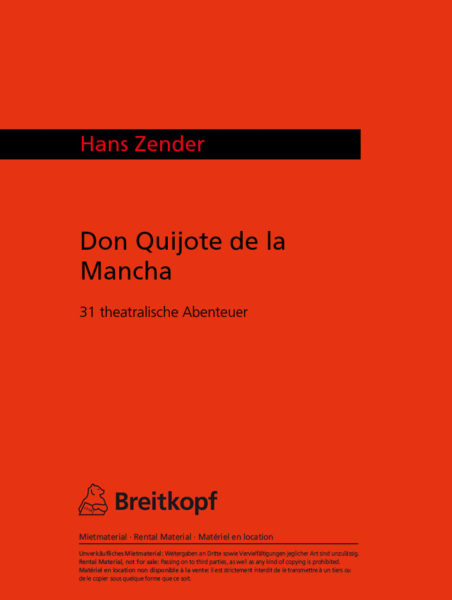Hans Zender (1936–2019) Don Quijote de la Mancha
31 theatralische Abenteuer 1989-91/1994 Dauer: 165' Text: Hans Zender
11 Solisten – 1(Picc).1.1(A-Sax).1(Kfg) – 0.1.1.1. – Schl(4) – Git – Cimb.Klav.Synth(Sampler) – Str.: 1.1.1.1. – Live-Elektronik
Uraufführung: Stuttgart, 3. Oktober 1993
Uraufführung der Neufassung: Heidelberg, 23. Januar 1999
AD: abendfüllend
Libretto: Hans Zender nach Cervantes gleichnamigem Roman
Ort und Zeit: Spanien, Anfang des 17. Jahrhunderts
Personen: Don Quijote (Bariton) - Sancho Panza (Tenor) - Nichte / Lucinde / Herzogin / Dulcinea I / Dame I (Sopran) - Nachbarin / Dorothea / Dulcinea II / Dame II / (Hofdame I) / (Engel) (Mezzosopran) - Haushälterin / Orakel / Dulcinea III / Dame III / (Hofdame II) / (Königin) (Alt) - Knabe (metallische Kinderstimme / Sprechstimme) - Barbier I / Lektor I / Häscher I / (Teufel) / (Don Pedro) (Tenor) - Cardenio / Löwenwärter / (Soldat) / (1. Höfling) / (Küster) / (Lektor IV) (Tenor) - Verwalter / Barbier II / Lektor II / (Tod) / (Schweinehirt) (Bariton) - Lektor III / Häscher II / 2. Höfling (Bassbariton) - Don Fernando / Herzog / (Der Schatten) / (Spiegelritter) / (Notar (stumme Rolle)) (Bariton) - Pfarrer / Wirt / Merlin / (Kaiser) / (3. Höfling) / (Lektor V, „Der Chef“) (Bass) Weitere Sänger, Statisten, Schauspieler, Pantomimen, Doubles ad lib. Die eingeklammerten Doppelbesetzungen können auch von zusätzlichen Sängern übernommen werden.
Don Quijote de la Mancha besteht aus 31 jeweils in sich geschlossenen, in den theatralischen Mitteln unterschiedlich definierten Stücken. Die ersten 16 Stücke bilden den 1. Akt (Dauer: ca. 11/2 Stunden), der 2. Akt dauert ca. 11/4 Stunde.
Die Einzelstücke (Dauer: zwischen 3 und 6 Minuten; Ausnahme: Finale 1. Akt, Dauer: ca. 12 Minuten) können theoretisch auch einzeln bzw. in einer frei zusammengestellten Teilauswahl von Stücken gespielt werden. (Dabei lässt sich ohne weiteres auch an eine Folge denken, die ausschließlich Szenen ohne Elektronik verwendet.) In der vollständigen Fassung sollen die 31 Stücke in 9 Gruppen aufgeteilt werden; die Stücke jeder Gruppe gehen bruchlos ineinander über, die Gruppen sind durch nicht zu lange Zäsuren voneinander getrennt. Nach dem 1. Akt große Pause.
1. Nr. 1 - 3
2. Nr. 4 - 7
3. Nr. 8 - 10
4. Nr. 11 - 14
5. Nr. 15 + 16
--- -----
6. Nr. 17 - 19
7. Nr.20 - 22
8. Nr. 23 - 28
9. Nr. 29 - 31
Alle Stücke, soweit sie sichtbar auf der Szene spielen, haben an ihrem Ende einen blitzartigen Vorhang bzw. Blackout.
Don Quijote ist für 12 Soli (11 Sänger und 1 Kind) konzipiert; es steht den Aufführungsleitern aber frei, weitere Sänger hinzuzuziehen (oder auch Statisten, Schauspieler, Pantomimen), Partien zu doubeln etc.
Einige Stücke können auch vorproduziert und als Tonbandeinspielungen realisiert werden (siehe Einzeleinführungen).
Der Komponist hat in diesem Werk sein strukturelles Denken auch auf gewisse Aspekte der szenischen Darstellung ausgedehnt. Er baut die Form auf 5 Grundelementen auf, die er GESANG, SPRACHE, INSTRUMENTALSPIEL, BILD und AKTION nennt. Jedes der 31 Einzelstücke wird aus einer unterschiedlichen Kombination dieser 5 Grundelemente gebildet - nur eines (Finale 1.Akt) enthält alle 5 Elemente.
Auch BILD und AKTION sind so in die musikalische Form einbezogen; diese Elemente werden in der gleichen Weise wie die traditionell ,„musikalischen“ Elemente zeitlich strukturiert. Alle Entscheidungen, die den Raum betreffen, bleiben Sache des Regisseurs bzw. des Bühnenbildners. Fern davon, deren Phantasie einschränken zu wollen, will ihnen der Komponist im Gegenteil einen besser definierten Spielraum eröffnen, mit dem Ziel, eine stärkere Integration von optischen und akustischen Abläufen zu ermöglichen.
Unter BILD wird ein unbewegtes szenisches Tableau verstanden, ein ,„lebendes Bild“, wie es in der Goethe-Zeit beliebt war. AKTION dagegen bedeutet eine Bühnensituation, in der alles in Bewegung ist und nichts - auch kein Requisit oder ,„Bühnenbild“ - fest an einem Ort bleibt. BILD plus AKTION bedeutet die Integration beider Elemente, in jeweils pro Stück neu definierter Weise. Ist weder BILD noch AKTION vorgesehen, so gibt es überhaupt keine Szene: wie immer der Regisseur diese Situation auch konkret definieren will. Bei den sichtbaren Szenen kann der Regisseur die kompositorischen Strukturen aufgreifen und fortsetzen: etwa in einer autonomen Beleuchtungsstruktur oder durch Einbeziehung von Live-Videokameras, die ein Pendant zur - etwa die Hälfte der Stücke prägenden - Live-Elektronik der Musik wären.
Bibliografie:
Ermen, Reinhard: Versuchsanordnungen des Musiktheaters. Hans Zenders Opern, in: Programmheft der Inszenierung Frankfurt, 6. Dezember 2016 (Ensemble Modern@Frankfurt LAB), S. 19-21.
Hiekel, Jörn Peter: Form-Abenteuer als Spiegel. Hans Zenders Musiktheaterwerke „Don Quijote de la Mancha“, in: Programmheft der Inszenierung Frankfurt, 6. Dezember 2016 (Ensemble Modern@Frankfurt LAB), S. 14-17.
Schmidt, Dörte: „Die Bilder werden neu entdeckt, aber als Zeichen, die der Vergangenheit angehören“. Zenders Musiktheater und die Instanz der Geschichte, in: Hans Zender. Vielstimmig in sich, hrsg. von Werner Grünzweig, Jörn Peter Hiekel und Anouk Jeschke (= Archive zur Musik des 20. und 21. Jahrhunderts, Band 12), Hofheim: Wolke 2008, S. 77-89.









